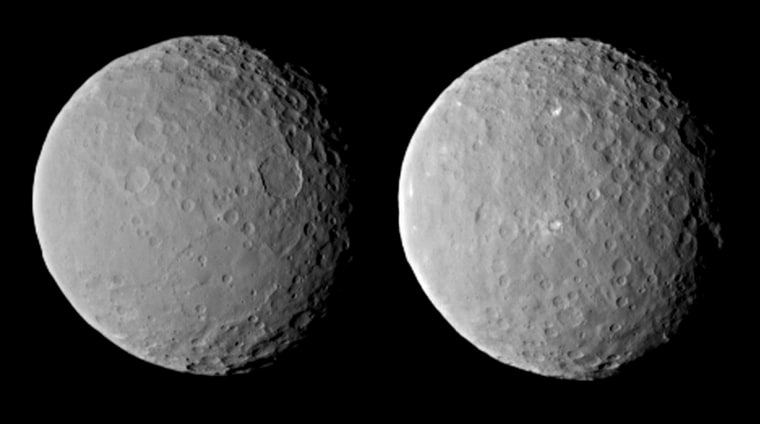NASA's Dawn spacecraft is getting sharper views of the mysterious bright spot on the dwarf planet Ceres as the probe prepares to go into orbit — and it turns out that the spot is actually two spots, lying next to each other in the same big crater basin.
Could the spots be patches of ice, welling up from the interior of the biggest asteroid and the smallest known dwarf planet? Stay tuned.
"Right now, all we can say is that the material reflects 40 percent or more of the light falling on it," UCLA astronomer Chris Russell, the principal investigator for the Dawn mission, told NBC News in an email. "This limit is because of the resolution of the camera at this distance from Ceres. If the final answer ... is that it reflects all the light that falls on it, then the most probable reflector would be ice."
In a news release accompanying the pictures released on Wednesday, Russell said the spots may have a "volcano-like origin," but added that such an interpretation would depend on the sharper images to come. Last year, scientists reported detecting water vapor escaping from Ceres — leading them to speculate that water might be welling up from beneath the surface.

These newly released pictures were taken on Feb. 19, when the refrigerator-sized spacecraft was nearly 29,000 miles (46,000 kilometers) away from Ceres. The Dawn probe — which was launched in 2007 and spent the first part of its mission studying the asteroid Vesta — is due to go into orbit around Ceres on March 6. Over the course of the following year, Dawn will map the 590-mile-wide (950-kilometer-wide) mini-world from an altitude eventually swinging as low as 232 miles (373 kilometers).
Andrea Nathues, lead investigator for Dawn's framing camera team at Germany's Max Planck Institute for Solar System Research, said the white spots are still too small to resolve with the team's camera, but it's already known that they're brighter than anything else on Ceres.
"This is truly unexpected and still a mystery to us," Nathues said.
In his email, Russell noted that the brightest bodies in the outer solar system are those with icy surfaces.
"These would not last on Ceres, and so Ceres has a dark surface," Russell said, "but if there were ice below the surface it might be occasionally exposed a little bit."
What if the spots aren't made of ice? "There could be salt on the surface, which would be more reflective than the general claylike material we think covers much of the surface," Russell said. "So there is a range of possibilities."
Even though the origin of the spots could be volcano-like, scientists have ruled out the possibility that the spots are made up of lava like that seen on Earth or on Io, one of Jupiter's moons.
"That would make a hot spot," Russell said. "We think we would have noticed a hot spot by now."
NASA will present a news briefing at noon ET March 2 focusing on the arrival of the Dawn spacecraft at Ceres. The briefing will be aired live via the NASA TV website as well as Ustream.